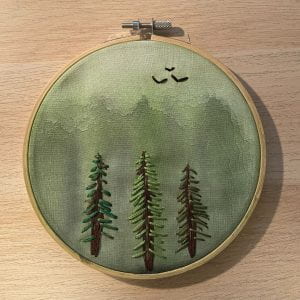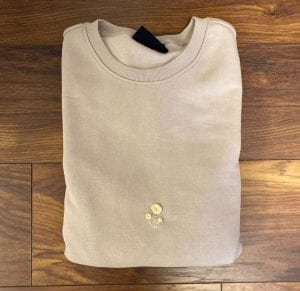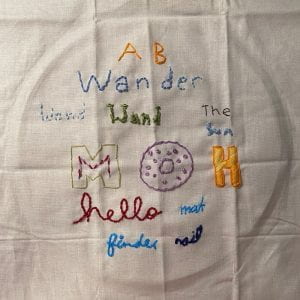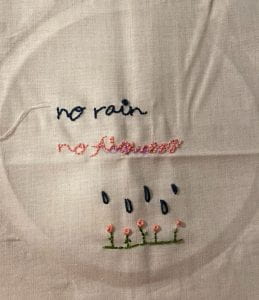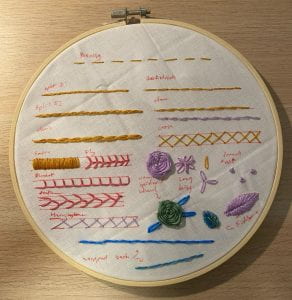“Love is what carries you, for it is always there, even in the dark, or most in the dark, but shining out at times like gold stitches in a piece of embroidery. ”
– Wendell Berry
Welcome back!
This week’s post will be my last blog post for In-Depth 2022. I will be giving one last progress report on my project, mentor, and my plans for In-Depth Night at the end of May.
Progress Report
Over the past two weeks I’ve gone a little slower since I’ve had some upcoming events to focus on, and I mostly worked on designs for my project. I had a call with Michelle talking about some ideas I could do for my final project, and we were talking about something like a flower field with a painted background and a quote. I chose to try and incorporate those ideas the most since they are the main patterns I’ve learnt to embroider throughout In-Depth. After our meeting I drew up some ideas with those main components, and I also drew some mains shapes I would colour in with watercolours as a part of the background.
As for the project itself, I will be working on it over the next little while, updating Michelle as I progress. As for the piece itself, I will probably be using a larger hoop, most likely my 8 inch hoop, as I want to make this project a fancy finishing project.
Mentor
Over the past two weeks Michelle and I had a meeting discussing my last project (scenery) and ideas for my final project. I told her about the meltdown I had with the watercolours on my previous piece and told her that I would try to make a background again but with thicker paints this time. We discussed ideas for my final project, and I told her about some of my ideas and she told me some of hers. We agreed that I would draw up some designs and send them to her so she could help me choose what my final project would look like.
In-Depth Night
For In-Depth night, I’m planning on having a table where I will be displaying all my projects, and I will also be working on a project in front of people. I will display the projects I’ve made, and I will likely buy a small paint easel to prop up on or two of the pieces. I will also be bringing my embroidery supplies (thread, needles, hoop, fabric, etc.) and will be creating a project at my table, answering any questions and explaining what I am doing as I go.

Journal
Below is a PDF of a journal I kept to write updates and more detailed descriptions of projects.
Updated Timeline
|
Plan: An outline of methods, activities, strategies, people, and resources you can use to meet your challenge |
Timetable: The specific dates or times when you will accomplish the steps in your plan |
| Find a vision or goal. | Before December 17th (done) |
| Find and contact a mentor. | Before December 20th (done) |
| Make sure mentor has completed necessary forms. | January 12th (done) |
| Do some research on embroidery. | December 31st – January 10th (done) |
| Start finding stitches I want to learn. | January 3rd – January 10th (done) |
| Find four types of patterns that I want to work on and two types of fabrics. | Before January 31st (done) |
| Buy (most) needed supplies. | Before January 31st (done) |
| Start learning and practicing stitches. | January 16th – January 31st (done) |
| Start practicing a certain genre and complete a design for first mini project. | Before January 31st (done) |
| Finish first mini project. | February 6th (done) |
| Learn to care for finished product. | February 6th (done) |
| Start working on second genre. | February 7th (done) |
| Finish and care for second project. | February 28th done) |
| Finish and care for third project. | March 28th (done) |
| Finish and care for fourth project. | April 18th (done) |
| Finish final project. | May 22nd (in progress) |
| Complete a journal of what I have learnt and this journey. | May 28th (done) |
